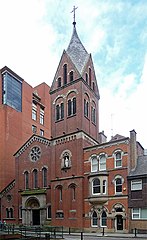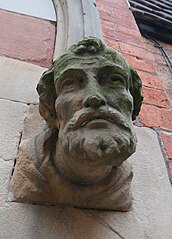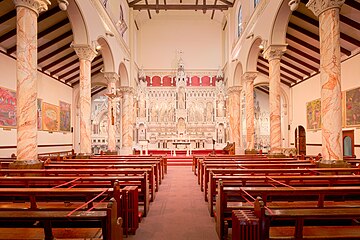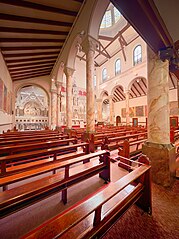
The Cathedral Church of St. Barnabas is a cathedral of the Roman Catholic Church in the city of Nottingham in Nottinghamshire, England. It is the mother church of the Diocese of Nottingham and seat of the Bishop of Nottingham. The cathedral is a grade-II* listed building.

The Metropolitan Cathedral Church and Basilica of Saint Chad is a Catholic cathedral in Birmingham, England. It is the mother church of the Archdiocese of Birmingham and is dedicated to Saint Chad of Mercia.
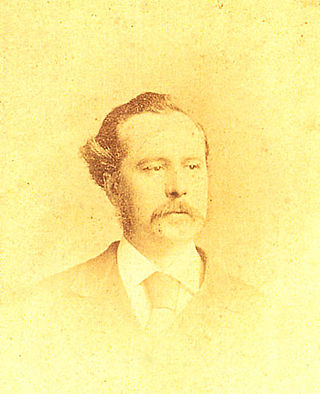
Edward Welby Pugin was an English architect, the eldest son of architect Augustus Welby Northmore Pugin and Louisa Barton and part of the Pugin & Pugin family of church architects. His father was an architect and designer of Neo-Gothic architecture, and after his death in 1852 Edward took up his practice. At the time of his own early death in 1875, Pugin had designed and completed more than one hundred Catholic churches.
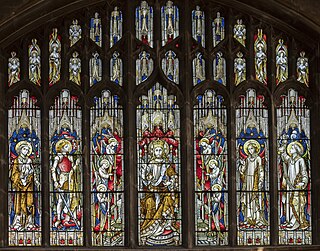
Hardman & Co., otherwise John Hardman Trading Co., Ltd., founded 1838, began manufacturing stained glass in 1844 and became one of the world's leading manufacturers of stained glass and ecclesiastical fittings. The business closed in 2008.

The Cathedral Church of St. John the Evangelist, usually known as Salford Cathedral, is a Catholic cathedral on Chapel Street in Salford, Greater Manchester, England. It is the seat of the Bishop of Salford and mother church of the Diocese of Salford, and is a Grade II* listed building.
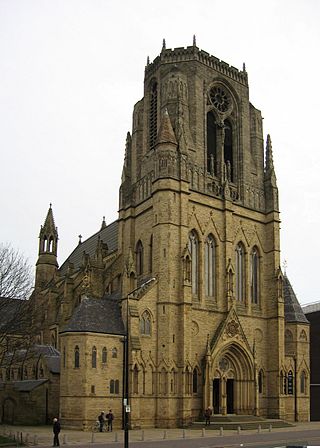
The Church of the Holy Name of Jesus on Oxford Road, Manchester, England was designed by Joseph A. Hansom and built between 1869 and 1871. The tower, designed by Adrian Gilbert Scott, was erected in 1928 in memory of Fr Bernard Vaughan, SJ. The church has been Grade I listed on the National Heritage List for England since 1989, having previously been Grade II* listed since 1963.

St Mary's Church is a Roman Catholic church in the city of Derby, England. A Grade II* listed building, it stands on Bridge Gate overlooking St Alkmund's Way. The church was designed by architect A. W. N. Pugin and according to Simon Jenkins, it is one of Pugin's "few complete works".
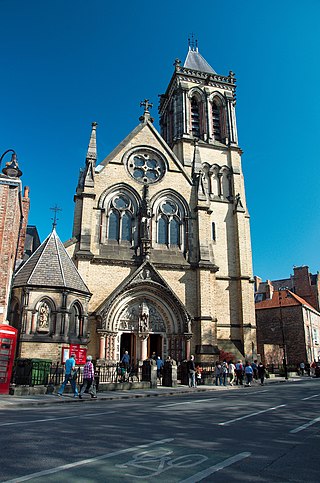
George Goldie was an English ecclesiastical architect who specialised in Roman Catholic churches.

The Church of St Thomas of Canterbury and English Martyrs is the Roman Catholic church serving St Leonards-on-Sea, a town and seaside resort which is part of the Borough of Hastings in East Sussex, England. The present church, which combines a plain, unadorned Gothic Revival exterior with a lavishly decorated interior featuring extensive early 20th-century paintings by Nathaniel Westlake, is the third building used for Roman Catholic worship in the seaside resort. James Burton's new town of 1827, immediately west of Hastings, was home to a convent from 1848; public worship then transferred to a new church nearby in 1866. When this burnt down, prolific and "distinguished" architect Charles Alban Buckler designed a replacement. The church remains in use as the main place of worship in a parish which extends into nearby Hollington, and has been listed at Grade II by English Heritage for its architectural and historical importance.

St Mary's Church is in the village of Yealand Conyers, Lancashire, England. It is an active Roman Catholic church in the diocese of Lancaster, and is linked with the churches of St Mary of the Angels, Bolton-le-Sands, and Our Lady of Lourdes, Carnforth. The church is recorded in the National Heritage List for England as a designated Grade II listed building. It stands at the south end of the village.

Cheetham Hill Road is a road in north Manchester, England, running from Corporation Street in Manchester city centre, through Cheetham to Prestwich. In Crumpsall, its name changes to Bury Old Road.
The Pippet Family are a family of designers and artists based in Warwickshire and Birmingham, who specialised in Catholic decorative schemes for churches, ecclesiastical metalwork and stained glass windows as well as some textile items. They were part of the British Gothic Revival, notably working for John Hardman & Co in the style of Pugin.

The Oratory Church of Saint Chad's, Manchester is a Grade II listed Catholic church in Cheetham Hill, Manchester, England. It was constructed between 1846 and 1847, on the east side of Cheetham Hill Road. The parish functions under the jurisdiction of the Roman Catholic Diocese of Salford.
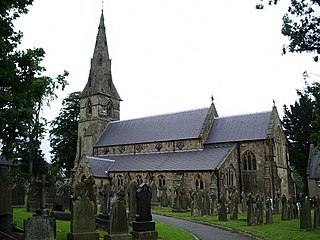
St John the Evangelist's Church is in Ribby Road, Kirkham, Lancashire, England. It is an active Roman Catholic parish church in the diocese of Lancaster. The church was designed by A. W. N. Pugin, and is recorded in the National Heritage List for England as a designated Grade II listed building.

Our Lady and the Apostles Church is a Roman Catholic parish church in the Edgeley area of Stockport, Greater Manchester, England. It was built from 1903 to 1905 and replaced St Philip and St James Church, built in 1803, which was the first permanent Catholic church to be built in Stockport after the English Reformation. It is situated on the corner of Shaw Heath and Greek Street, south west of Stockport College and south of Stockport railway station. It was built in the Gothic Revival style by the architect Edmund Kirby and is a Grade II listed building.

Our Lady of Mount Carmel and St Patrick Church or St Patrick's Church is a Roman Catholic Parish church in Oldham, Greater Manchester, England. It was founded in 1858 and was built in 1870. It is situated on the corner of John Street and Union Street West, north of Oldham Sixth Form College in the centre of the town. It is a Gothic Revival church and is a Grade II listed building.

St Peter's Church is a Catholic church in Woolwich, South East London. It is situated between Woolwich New Road and Brookhill Road, the main entrance being on Woolwich New Road. The church was designed by Augustus Pugin in 1841–42 in the style of the Gothic Revival and is one of only three Pugin churches in London. Pugin's design remained unfinished as the projected tower and spire were never built. The parish of St Peter the Apostle serves the Catholic community of central Woolwich and surrounding areas, and is part of the Archdiocese of Southwark which is in the Province of Southwark.

Corpus Christi Roman Catholic Church, Maiden Lane, is a Roman Catholic church in Maiden Lane, Covent Garden, in the Westminster City Council area of London, England. The church building, in Early English Gothic style, is grade II listed and was designed by F. H. Pownall; it was “specifically devoted to the adoration of the Blessed Sacrament.”
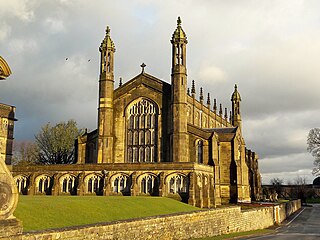
St Peter's Church is a Roman Catholic Parish Church in Stonyhurst. It is the parish church for Hurst Green, Lancashire and a chapel for Stonyhurst College. It was built from 1832 to 1835 and designed by Joseph John Scoles in the Gothic Revival style. It was founded by the Society of Jesus and has been served by Jesuit priests since. It is a Grade I listed building.


